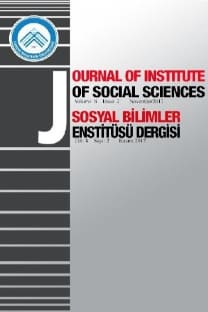Tercihlerde Benzerlik Teorisinin Sınanması: Fildişi Sahili Cumhuriyeti’nin Waemu’ya İhracatının Panel Çekim Modeliyle Analizi
Bu çalışmada Fildişi Sahili Cumhuriyeti’nin WAEMU ülkelerine (Benin, Burkina Faso, Gine Bisav, Mali, Nijer, Senegal ve Togo) yaptığı ihracat araştırılmıştır. “Tercihlerde Benzerlik Teorisi” bağlamında yapılan çalışmada, Panel Data yöntemi ve Panel Çekim Modeli kullanılmıştır. Analiz 2001-2014 yıllarını kapsamaktadır. Analiz sonucuna göre, Fildişi Sahili Cumhuriyeti’nin ihracatı ile WAEMU ülkelerinin okyanusa kıyısının olması, ortak kara sınırlarının olması ve nüfuslarının fazlalığı arasında doğru yönlü ilişki tespit edilmiştir. Ancak Fildişi Sahili Cumhuriyeti’nin ihracatı ile WAEMU ülkelerinin Fildişi Sahili Cumhuriyeti’ne fiziki uzaklıkları arasında ters yönlü ilişki bulunmuştur.
Similarity in Preference Theory’s Testing: The Republic of Ivory Coast’s Export to Waemu With Analysis Panel Gravity Model
In this study, export of the Rebuplic of Ivory Coast to WAEMU countries (Benin, Burkina Faso, Guina Bissau, Mali, Niger, Senegal and Togo) export is investigated. In the study, Panel Data and Panel Gravity Model methods were employed. This paper is examined in the context of “Similarity in Preference Theory”. This analysis involves the years from 2001 to 2014. As a result it is determined that there is a positive relation between export of the Rebuplic of Ivory Coast and having a coast, having a common boundary, the amount of people of WAEMU countries. But there is a negative relation between export of the Rebuplic of Ivory Coast and the physical distance of WAEMU countries to Ivory Coast.
Keywords:
WAEMU, Export, Population, Land Border Coastal Stretch,
___
- Ata, S. (2013). Türkiye’nin İhracat Potansiyeli: Çekim Modeli Çerçevesinde Bir İnceleme. International Conference on Eurasian Economies, 17-18 September http://www.avekon.org/papers/773.pdf, Erişim Tarihi: 01.02.2016. 2013, St. Petersburg, Russia,
- Atik, H. (2006). Tercihlerde Benzerlik Teorisi: Türkiye ve Bazı Komşu ÜlkelerinDış Ticareti Üzerine Bir Analiz. Ankara Üniversitesi Siyasal Bilgiler Fakültesi Dergisi, 61(2): 33-45.
- Baltagi, H. B. (2005). Econometric Analysis of Panel Data. Third Edition: West Sussex, John Wiley & Sons Ltd., United Kingdom.
- Batra, A. (2004). India’s Global Trade Potential: The Gravity Model Approach. Indian Council For Research on International Economic Relations http://icrier.org/pdf/WP_151R.pdf, Erişim Tarihi: 25.12.2015. Working Paper No. 151,
- Bhagwati, N. J. (1988). Protectionism. MIT Press, Cambridge.
- CAHF (Centre for Affordable Housing Finance in Africa), (2012). The West African Economic and Monetary Union WAEMU (UEMOA). http://www.housingfinanceafrica.org/wp-content/uploads/2012/10/ WAEMU.pdf, Erişim Tarihi: 25.12.2015.
- Chow, P.,Yochanan, M. K. (1999). A Test of the Linder Hypothesis in Pacific NIC Trade 1965 – 1990. Applied Economics, 31 (2): 175 -182.
- Dinh,T. B.,Nguyen, V. D., Cuong, H. M. (2011). Applying Gravity Model to Analyze Trade Activities of Vietnam. External Economics Review. No:69.
- Elshehawy, M. A.,Shen H., Ahmed, R. A. (2014). The Factors Affecting Egypt’s Exports: Evidence from the Gravity Model Analysis. Open Journal of Social Sciences, 2(11): 138-148.
- Genç, M. C., Berber, M. (2011). Bölgeselleşme ve Ticaret Akımları: Literatür İncelemesi. http://kosbed.kocaeli.edutr/sayi22/Genc_Berb r.pdf, Erişim Tarihi: 02.02.2016.
- Ghemawat, P. (2001). Distance Still Matters: The Hard Reality of Global Expansion. Harvard Business Review, 79(8): 137 - 147.
- Hejazi, W.,Safarian, E. A. (1999). Trade - Foreign Direct Investment and R&D Spillovers. Journal of International Business Studies, 30(3): 491 – 511.
- Hsiao, C. (2003). Analysis of Panel Data. Second Edition: Cambridge UniversityPress, United Kingdom. ITC
- (International Trade Centre), Bilateral Trade
- http://www.trademap.org/Bilateral_TS.aspx, Erişim Tarihi: 24.02.2015.
- Josheski, D, Apostolov, M. (2013). Macedonia’s Exports and the Gravity Model. Munich Personal RePEc Archive (MPRA), MPRA Paper No. 48180, July 2013, https://mpra.ub.unimuenchen.de/48180/1/MPR a_paper_48180.pdf, Erişim Tarihi: 12.12.2015.
- Kadılar, C. (2009). SPSS Uygulamalı Zaman Serileri Analizine Giriş, Bizim Büro Basımevi, Ankara.
- Kristjánsdóttir, H. (2005). A Gravity Model for Exports from Iceland. Centre for http://www.econ.ku.dk/cam/wp0910/wp0406/2005-14.pdf, Tarihi: 26.12.2016.
- Microeconometrics (CAM), 2005-14, Erişim
- Nguyen, B.X. (2010). The Determinants of Vietnamese Export Flows: Staticand Dynamic Panel Gravity Approaches. International Journal of Economics and Finance, 2(4): 122-129.
- Özer, O. O. (2014). Determinants of Turkey’s Textiles Exportation: The Gravitation Model Approach. Tekstil ve Konfeksiyon Dergisi, 24(3): 252-258.
- Prasai, P. L. (2014). Foreign Trade Pattern of Nepal: Gravity Model Approach. 2014 Nepal Rastra Bank, NRB Working Paper No.21, January 2014, http://www.nrb.org.np/ecorev/pdffiles/ nrbwp201421. pdf, Erişim Tarihi: 25.12.2015.
- Rahman, M. M. (2003). A Panel Data Analysis of Bangladesh’s Trade: The Gravity Model Approach. European Trade Study Group ETSG2003, Madrid, http://www.etsg.org/ETSG2003/papers/rahman.pdf, 03.01.2016. 11-13 September 2003, Tarihi: Erişim
- Sailors,W. J.,Qureshi, U. A., Cross, E. M.(1973). An Empirical Verification of Linder’s Trade Thesis. Southern Economic Journal, 40(2): 262-268.
- Saygılı, F., Manavgat, G. (2014). Linder Hipotezi: Türkiye’nin Dış Ticareti İçin Ampirik Bir Analiz. Ege Akademik Bakış, 14(2): 261-270.
- Seck, D., (2013). Fifteen Years of WAEMU: Results and Strategies for the Future.Wealth through Integration, Regional Integration and Poverty- Reduction Strategies in West Africa (Ed. Elias T. Ayuk, Samuel T. Kaboré),19-42,http://www.springer.com/cda/content/ document/cda_download =0-0-45-1356727-p174 512193, Erişim Tarihi: 12.12.2015.
- document/9781461444145-c1.pdf?SGWID
- Seyidoğlu, H. (2003). Uluslararası İktisat. Güzem Yayınları, İstanbul.
- Suresh, K.G.,Aswal, N. (2014). Determinants of India’s Manufactured Exports to South and North: A Gravity Model Analysis. International Journal of Economics and Financial Issues, 4(1): 144-151.
- Waheed, A., Abbas, S. (2015). Potential Export Markets for Bahrain: A Panel Data Analysis, International Journal of Trade Economics and Finance, 6(3): 165-169.
- ISSN: 1309-3738
- Yayın Aralığı: Yılda 2 Sayı
- Başlangıç: 2010
- Yayıncı: Prof. Dr. Coşkun POLAT
Sayıdaki Diğer Makaleler
Örgütlerde Zenginliğin Kaynağı Olarak Farklılıkların Yönetimi: Kavramsal Bir İnceleme
Yavuz DEMİREL, B. Dilek ÖZBEZEK
Oğuz Atay’ın “Unutulan” ve “Korkuyu Beklerken” Adlı Hikâyelerinde Gotik Unsurlar
İslam Hukuku Açısından Mahremiyet-Zaman İlişkisine Mukayeseli Bir Bakış
Kripto Para Birimleri, Bitcoin ve Muhasebesi
Kurumsal Yönetim Uygulamalarının Denetim Kalitesine Etkisi Üzerine Bir Araştırma
Küçük Frank Yıllıkları I: Aziz Amand Yıllığı
“PESTEL Analizi” ile Türkiye-Almanya Ekonomik İlişkilerinin İncelenmesi
Hasan AKÇA, Levent ŞAHİN, Zekayi KAYA
Personel Güçlendirme ve Sağlık Sektörü
Uğur UĞRAK, Gülsün ERİGÜÇ, Yasin UZUNTARLA
Ebeveynlerin Medya Okuryazarlık Düzeylerinin Farklı Değişkenler Açısından İncelenmesi
